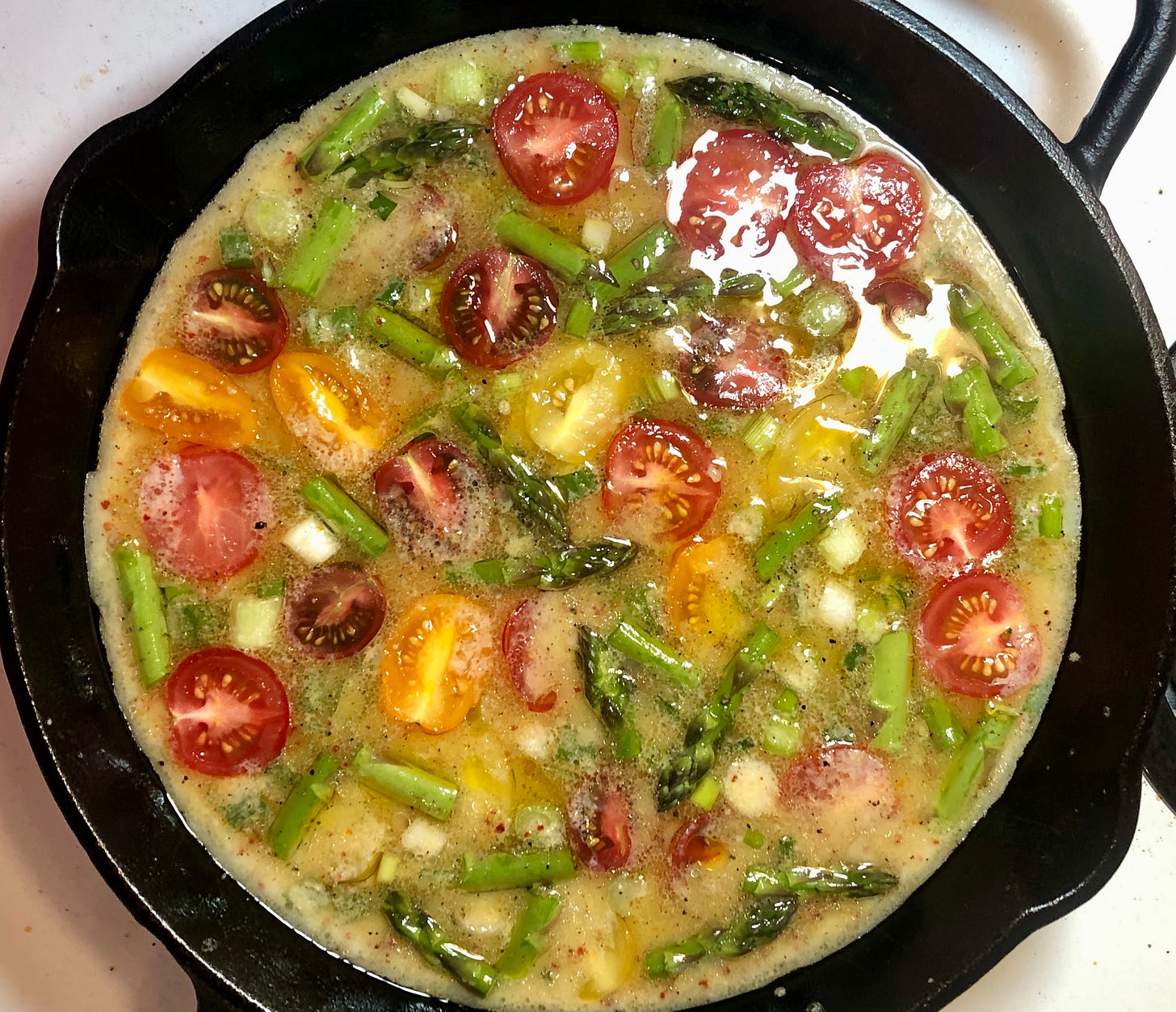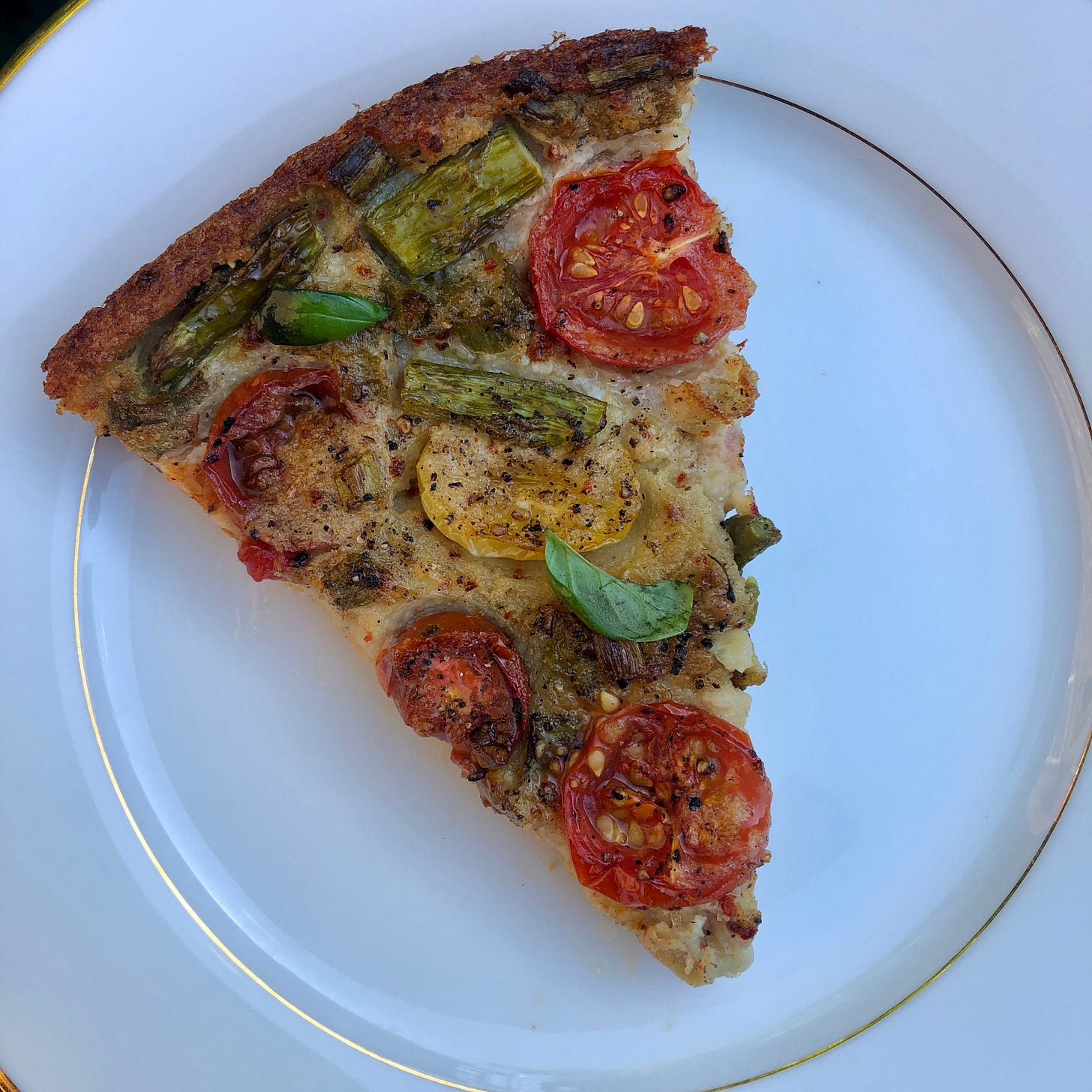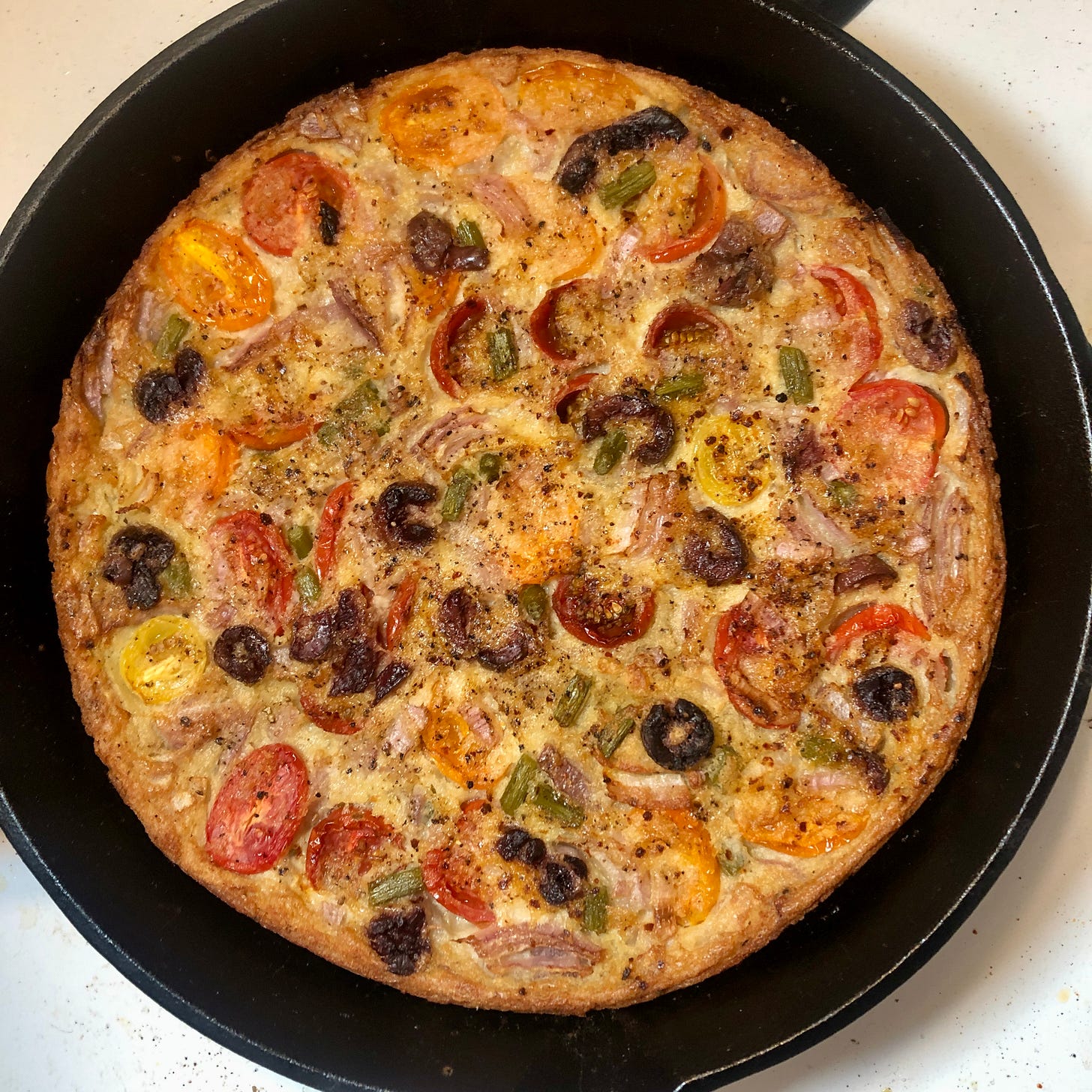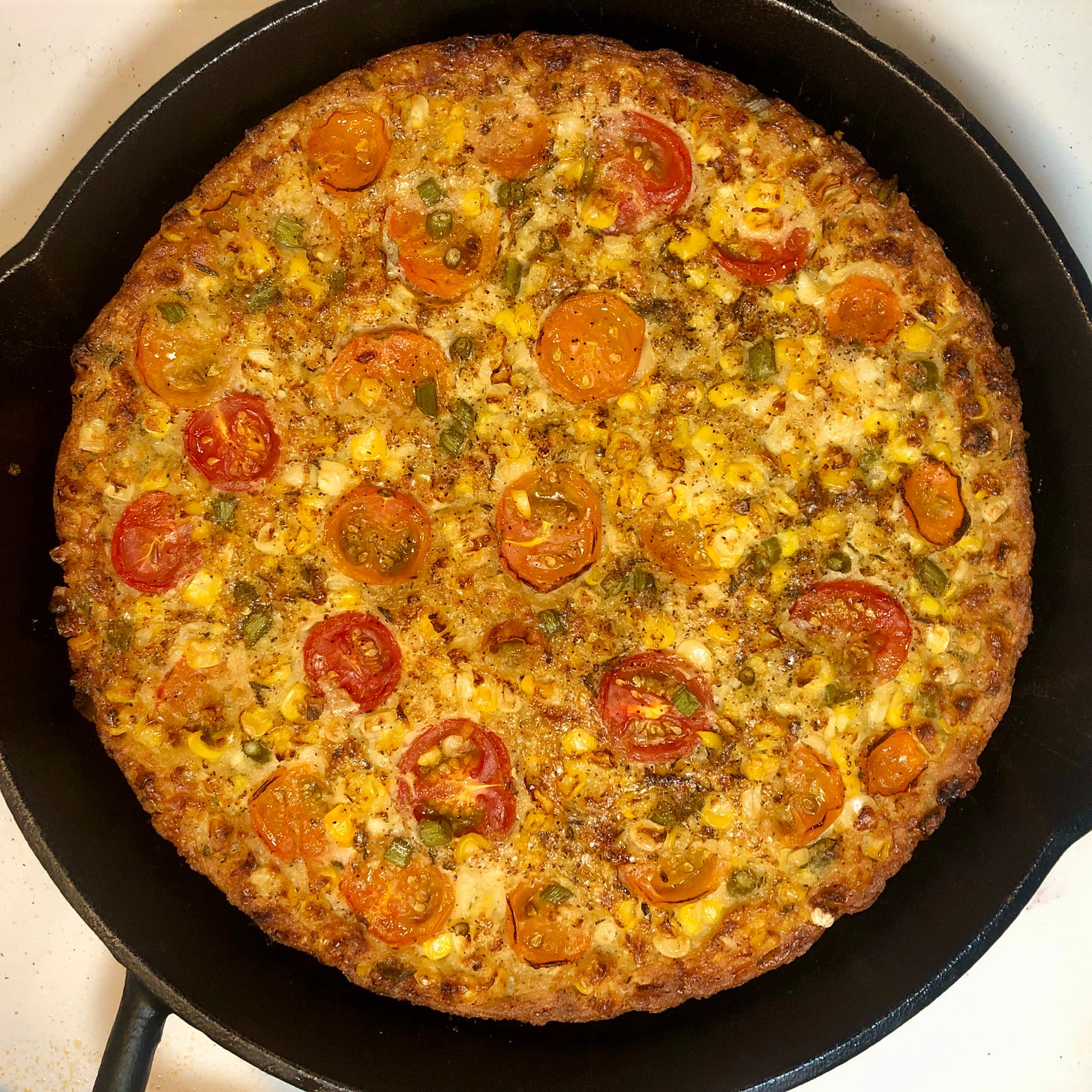Off the top, don’t worry! Beyond the title I won’t be contributing further to the middle-aged-woman-co-opting-brat-discourse, uh, discourse. The phrase was simply stuck in my head. Because this year’s tomato tart isn’t really a tart at all, but rather a farinata with tart energy. Which, I mean, if that isn’t brat, I’m really not sure what is? But I said I wouldn’t do this so I’ll stop right there and leave it to you to decide once you’ve made it. (It’s brat).
As some of you may remember, my very first post, in August of 2022 was a recipe for a tomato tart with a whipped tofu filling.
I decided to make it a tradition last August, with a veganized version of Alison Roman’s tomato tart from Sweet Enough that uses doenjang in the crust in lieu of parmesan.
If I do say so myself, those tarts are really good, and I hope you’ll try them one day. But I can’t deny they’re both a bit of a faff, what with one requiring a blender, and the other making you toast almonds in advance.
This year, I wanted something very delicious obviously, but also dead easy — no pre-cooking of anything, no appliances aside from the oven. I also wanted a tart that can be a reasonably healthy vegan meal in itself, maybe alongside a little salad. This tarty farinata hits all the bases. After I made the first one, I literally made it once a week thereafter. It’s that good, that easy, adaptable to any herb and spice profile you like, and — maybe the best part — you can make it in the morning before the swamp-heat sets in, pop it in the fridge, and serve it for dinner at room temp, microwaved, or totally cold. In my humble opinion it’s a hit all the ways, and definitely benefits from cooling off at least a little before slicing so it attains its final firmness.
So what’s a farinata?
Should you not be Italian (or from the south of France, or from northern India with its very similar besan chilla), you may not be familiar with this magical food that kind of rides the line between pancake and flatbread. But then again, maybe you’ve been making them for years. It seems to me that farinata (and its French cousin, socca) is finally getting her day in the North American sun, and I couldn’t be more pleased to see it.
started writing about making farinata regularly back in the spring of 2022; ’s been impressing me with her herb-green soccas for a few years now as well.In June,
published this beautiful onion-y number in the New York Times (gift link); and maybe most exciting of all to me was discovering that a newish cafe near my apartment, The Company We Keep, sells farinata by the slice, their version studded with thick slices of potato and fragrant rosemary. And you can just go get it any time! For breakfast! For lunch! For a snack! (The whole cafe is fabulous, Torontonians please go there!)At risk of sounding like one of those boys at my high school who droned on about being into Nirvana “since Bleach,” farinata and I actually go way back. I first learned of it from my favourite cookbook of all time, The Cranks Bible by Nadine Abensur that I got from a bargain bin in 2002. To quote my own homage to that book, Abensur’s “recipe for farinata introduced me to the magic of chickpea flour—vegan eggs, did you know?”
I read Cranks over and over as I taught myself to cook vegetarian during grad school, yet I somehow didn’t notice the farinata recipe until 2005 when I was trying to woo and impress my then-new vegan boyfriend, David (origin story of most of my recipes). The first time I made the farinata, the planets aligned, it set “in thick slabs that look and cut like a frittata” just as Abensur promised. My mind was blown! So very egg-like, so very easy! At the time, though, I didn’t have a cast iron pan. I had early luck in a pyrex dish, but subsequent attempts — especially when I tried to do the “not particularly authentic” thicker version Abensur describes — either didn’t brown well, stuck miserably to the sides of my skillet, or wound up with mushy, undercooked middles. Though I knew the farinata was incredible in concept, I all but gave up for a few years, unable to nail what I wanted at home. I remember whining to David, “Why don’t restaurants serve this for brunch? It’s vegan and gluten-free by default, and it’s really a lot like eggs.” So you can see why its appearance at The Company We Keep was so very exciting to me; I’ve been dreaming of this for years!
My interest in making farinata myself was reignited when I found myself rather by mistake in Santa Margherita Ligure in the Italian Riviera in the spring of 2013. My best friend Maggie’s whole family was going on a mediterranean cruise, a gift from her late grandmother. At the very last minute, Maggie’s husband, a hilarious comedian, landed a role on a sitcom and I took his spot on the cruise?? The whole thing felt like a weird dream, we laughed our way through Pompei and Marseilles, consuming the most incredible carbs everywhere we went.

As our ship headed toward Liguria, I tried to remember why the area sounded familiar, and then I remembered: farinata! That’s where it lived! I pulled just enough Italian words together to ask about it in a couple of Santa Margherita bakeries, and somehow came to understand that while I was correct — farinata was a food to be had there — the season was wrong, it was a winter thing. We had to console ourselves with the absolute best onion focaccia either Maggie or I have had before or since, which we ate in rapturous silence, gazing upon the azure sea. Poor me.
Okay, that story kind of goes nowhere, maybe I just wanted to reminisce about that trip and that bread. The point is I was reminded of farinata’s existence and I started trying again. By then I was a much better cook, had procured a cast iron pan, and over time I figured out my favourite way to make these guys — indeed totally inauthentically, almost an inch thick with lots of toppings baked right along with it. This year I also discovered that you can make farinata with fava bean flour when you get sick of chickpea, so I’m including that option as well. Is what I’m sharing here even a farinata anymore? I’m not sure.
What I do know is that it’s brat. I’m kidding! What I do know is that I brought a few slices of the fava variation, topped with tomatoes, scallions, and furikake to Maggie’s place last month. I didn’t tell her what was in it, and she enthusiastically said, “Is it supposed to be like eggs? It’s giving quiche.” To be clear, Maggie is not vegan, has had egg-based quiche in recent years, and she loved this dish. David loves this dish. Other friends, some vegan, some not, have gobbled this up. So whatever it is (aside from brat, which it is), do yourself a favour and make it.
Tomato Tart Farinata
Below I’m providing a base recipe, and a bunch of ways to riff on it. But please riff away on your own as well! It’s really customizable, with any seasonings you like, and you can add different vegetables, too. I’m nervous it’ll be too watery, but I think I’ll try some salted and drained zucchini next, we’ll see how it goes!
On the topic of watery-ness: one thing I definitely suggest is using cherry or otherwise small tomatoes. That way you can halve them and put them skin side down, and the skin will serve as a protective barrier preventing all the tomato juice from sogging up your farinata base. And the juicy tomato tops get a little caramelized, very nice! I haven’t tried with sliced large tomatoes, but I do fear things could get too wet, and I don’t want that for you. I’m also finding it hard to provide a precise amount of tomatoes to suggest, because it depends if you’re adding other vegetables, how small your small tomatoes are, etc. I suggest you have the equivalent of a full pint container of cherry-sized tomatoes on hand before you start to ensure you don’t run out, but if you have less, go for it anyway and eke it out with onions or sliced eggplant or some mushrooms or whatever!
I add the nutritional yeast, garlic, and onion powders to all of mine, just to add a little more flavour to the otherwise pretty neutral base. But I say they’re optional because you can fully make this if you don’t have all or one of those things. It’ll still be great!
While chickpea flour is very good and widely available these days, I do recommend trying fava flour as well for something very slightly different. Then you’ll also have it on hand for other vegan baking projects (I’ll be sharing a cool recipe that uses it soon!) You can order fava flour here if you’re in the States, or the brand I use from here in Canada.
Final thing: I highly recommend a ten inch cast iron pan for this. I think a twelve inch would work fine, too, but it would obviously make a thinner farinata, so might bake through in less time. If you don’t have a cast iron pan, treat yourself? Maybe it’s time.
Ingredients:
200 grams / 1 1/4 cup chickpea or fava bean flour
570 ml / 2 1/3 cup water (I just use tap water)
1 1/4 tsp fine sea salt (reduce if you use a spice mix with salt in it)
Black pepper to taste
1 tsp nutritional yeast (optional)
1/4 tsp garlic powder (optional)
1/4 tsp onion powder (optional)
Small pinch chile flakes (optional)
5 tablespoons olive oil, divided
350 grams / one pint container cherry or small tomatoes, halved. See headnote about tomatoes.
Other vegetables, herbs, and seasonings to make it your own (See below for ideas!)
Method:
In a large bowl, whisk together chickpea or fava flour, water, and salt. Set aside to rest and hydrate at room temperature at least one hour, or let it sit overnight in the fridge so you’re ready to go in the morning. If you’re in a rush, you can just let it rest while you prep the other ingredients. It’ll still taste great but it may not be quite as smooth-textured and nice. I’m also convinced I digest it better when it’s had a chance to soak, but I am no scientist!
When your batter has rested, preheat the oven to 425 degrees F (220 C) and place a rack in the middle of the oven (my oven only heats from the bottom, no fan).
Stir the rested batter and add the nutritional yeast, onion and garlic powders, chile flakes, pepper, and any other seasonings or herbs you like. The key is nothing too wet. Chopped green onion and corn kernels have worked great for me, and dried herbs of any kind are a nice addition.
Add three tbsp of olive oil to the batter, and add the remaining two tbsp of oil to your cast iron pan (mine is a ten inch). Place the pan in the oven to preheat for at least five minutes.
Meanwhile, halve the tomatoes and prepare any other vegetables you wish to add. See below for ideas.
When the pan is preheated, give the batter one more stir and pour into the pan. It will be very liquid! Don’t worry! It’s going to set up!
Float the tomatoes skin-side down in the batter. It’s okay if a few sink a little bit. Arrange any other vegetables — onions, eggplant slices, etc. — around the tomatoes, trying to let them kind of float on top as well like this:
Sprinkle with a little extra salt and pepper, and any other herb or spice mix you wish to add. If you’re worried about your herbs or green onions burning, you can also add these midway through the bake, or at the end.
Bake for 45 minutes. I turn the pan around about every fifteen minutes because I have an old crappy oven, and this helps it bake evenly. At the 45 minute mark, it should be golden brown, pulling away slightly from the sides of the pan, and feel fairly firm when you press on it with a fork. It may feel a bit softer around the vegetables. That’s okay!
If you’d like to brown the top and/or the tomatoes a little more, you can put it under the broiler for two or three minutes, but watch carefully so it doesn’t burn.
Take the tart out of the oven and let it rest at least 20 minutes before slicing and serving. Or let it cool completely and pack it up into the fridge to serve later. Tastes great hot and fresh, at room temperature, or cold.
Variations:
This one had a chopped green onion added to the base, and was topped with more green onion and some chopped asparagus spears I’d tossed in olive oil, salt, and pepper. I put some torn basil leaves on top before serving.
Here we have a pizza-inspired farinata, featuring red onions, lots of sliced olives, green onions (one chopped in the batter, one on top), maybe two teaspoons of oregano in the batter and more on top, and extra chile flakes (I used gochugaru (Korean chile flakes) for more flavour, less heat). Some crushed fennel seeds would’ve been good in here, too.
Again I put one chopped green onion in the batter here, and another on top, plus loads of sesame seeds added midway through the bake, a drizzle of soy sauce and sesame oil at the end, and a bunch of furikake sprinkled on top when it was still hot.
This one almost doesn’t deserve the “tomato tart” moniker in light of all the sliced Japanese eggplant, but…that’s fine? I salted the eggplant slices and let them sit around while I did everything else, then tossed them in olive oil and za’atar. I also added a chopped green onion and at least a tablespoon of za’atar to the batter, and topped with sliced red onion, more green onion, and lots more za’atar both midway through and at the end of the bake.
Finally, corn! The kernels from one ear went in the batter, along with two teaspoons of very nice creole seasoning mix that I bought in New Orleans, and a chopped green onion. I would add even more creole seasoning next time. Then the kernels from another ear of corn went on top, along with more green onion, more fancy creole seasoning, and a sprinkle of Tony Chachere’s creole seasoning as well, which is spicier and saltier (like the “cajun salt” at New York Fries. Anyone?)
Okay, that’s it, if you make this please let me know, tag me on Insta, whatever, I would love, love, love to hear about it! Also I’m trying to do a bunch of recipes in August while the produce is popping (they won’t all be this long!) If you’re into it, consider a paid subscription just for the month? Still on sale, $2.50 a month! But no pressure at all, for real.
















I'm so pleased to see people doing callbacks to earlier stuff from their newsletter, something about it feels lovely idk. I've always loved farinata but gave up making it a while ago when I became frustrated with my results haha. Maybe it's time to go back to that one with a new recipe!
Made this over the weekend with tomato, zucchini, red onion and extra garlic. So good and easy. I had all the ingredients on hand. I can see myself throwing this together at least once a week. Even better the next day!